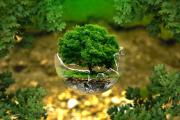Water Efficiency and Conservation: Important Even When Water is Abundant
June 2023 Update: Earlier this year, AWE’s President & CEO, Ron Burke, published a blog post about the multiple benefits of water efficiency and conservation. Since then, our team has transformed the high points from the blog and transformed it into a one-page fact sheet. There are two versions of the fact sheet with the same content but with different titles. One is entitled “Water Efficiency and Conservation: Important Even When Water is Abundant,” which may be best suited for communities where water supplies are or are perceived to be ample. The other is entitled “The Multiple Benefits of Water Efficiency and Conservation,” which can be useful anywhere, particularly in arid regions where benefits beyond water supply reliability may be overlooked.
Please use and share this resource as you see fit! The Water Efficiency and Conservation: Important Even When Water is Abundant version is available here, ![]() and The Multiple Benefits of Water Efficiency & Conservation version is available
and The Multiple Benefits of Water Efficiency & Conservation version is available here.
![]()
--------------------------------------------------------------------------------------------------------------------------------------------------------
Water efficiency and conservation are typically the fastest and least expensive ways to help ensure that communities and agriculture have access to affordable, sustainable water supplies. Making every drop of water count is especially important today, with climate change fueling hotter, dryer weather. Nearly every state experienced drought in 2022, including the worst drought in hundreds of years in the western U.S.
However, water efficiency and conservation offer multiple sustainability benefits beyond keeping the water running, just as energy efficiency does more than keep the lights on. As we celebrate Earth Day, it’s an excellent time to de-bunk the common misperception that water efficiency and conservation are only important in arid regions or when drought sets in.
Here’s a brief summary of water efficiency and conservation’s other benefits:
- Mitigating climate change by reducing energy use and greenhouse gas emissions associated with heating, pumping, and treating water/wastewater. Water and wastewater treatment plants are typically some of the largest energy consumers in cities. The Electric Power Research Institute estimates that treating, distributing, and heating water accounts for 1.8 percent of U.S. electricity consumption.
- Adapting to climate change by making communities more resilient to weather extremes. Water efficiency and conservation help communities adapt to droughts, which are expected to be more frequent and extreme due to climate change. It can also free up more capacity in sewer systems to manage heavy rain events that are expected to be more frequent and severe.
- Helping communities manage water shortages related to water quality problems. E-coli outbreaks and PFAs contaminants (“forever chemicals”) are just some of the water quality problems communities may face. Water supplies may be limited as communities shift to different supplies and/or ramp up treatment strategies. Recently, supply chain problems have also interrupted supplies.
- Making water bills more affordable. Water-efficient plumbing products can save an average family hundreds of dollars each year, according to the U.S. Environmental Protection Agency (U.S. EPA); this is especially important for low-income households.
- Reducing water infrastructure costs. Using less water can reduce the need to build or expand expensive drinking water and wastewater systems.
- Reducing costs for businesses and supporting corporate sustainability goals. Water efficiency and conservation can help companies save money and achieve corporate environmental sustainability goals that are increasingly prioritized.
- Supporting the sustainable, natural functioning of water resources and their broader ecosystems. Water efficiency and conservation can make more water available to support healthy stream flows and lake levels for plants and animals.
- Limiting nutrient runoff associated with over-irrigation. Landscape and agriculture water efficiency can help limit the amount of chemicals running off yards and farm fields into rivers, lakes, and oceans.
- Limiting property damage caused by leaks – a leading cause of real estate loss. Water efficiency strategies and technologies that detect leaks can save water and also help prevent property damage.
Despite these many benefits, water efficiency and conservation continue to be underfunded. State and federal governments leave nearly the entire tab for water efficiency to local water agencies, many of which are cash-strapped because of aging infrastructure, the cost of new environmental and public health protections, and inflation. New federal funding for water infrastructure should help local water providers, but only modest funding was allocated for water efficiency.
An analysis our staff conducted in May 2021, found that federal spending on energy efficiency and renewable energy outpaced spending on water efficiency and water reuse by approximately 80 to 1 between 2000 and 2020. In addition, AWE’s recent State Policy Scorecard for Water Efficiency and Sustainability found that only 17 states provide water efficiency funding, which is relatively small in most states.
You can help by asking state and federal lawmakers to invest in water efficiency. And for tips on how to use water wisely at home, check out AWE’s Home Water Works Website and Calculator ![]() to learn more.
to learn more.





